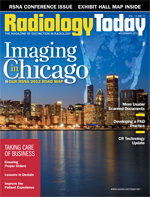 November 2012
November 2012
Putting Patients First
By Jim Knaub
Radiology Today
Vol. 13 No. 11 P. 3
As you probably know, “Patients First” is the theme of RSNA 2012. But just what should radiologists do to put patients first?
Diligent interpretations. Prompt, quality reports. Good communication with referrers and patients. I quickly jotted these things down on my list. And to the extent you are involved in image acquisition, provide a courteous, professional examination or procedure in your facility—delivered in accordance with ALARA principles—and demand the same kind of professional conduct from your staff. If you add being reasonably available to answer questions, I think you’ve covered the core of putting patients first.
RSNA packs its annual meeting schedule full of educational opportunities to improve knowledge and skills in all those areas. Obviously, the program contains numerous educational sessions designed to help radiologists hone their interpretation skills. It also offers courses intended to improve the reporting of what radiologists find. The same goes for communication; there are courses and technology designed to improve and speed communication from the imaging department to referrers and patients. Many, many of you take advantage of the meeting to advance and enhance your abilities.
RSNA president George S. Bisset III, MD, will deliver his presidential address, “Putting Patients First — Rhetoric or Responsibility?” on Sunday, November 25. I’m confident that Bisset will come down on the side of responsibility, in some way addressing what radiologists should do to put patients first. Yet, somehow, it feels like someone else is doing the defining without really explaining what it actually means to put patients first. Putting patients first, presumably, leads to satisfied patients. You certainly hear a lot of talk from healthcare systems about patient satisfaction, yet there’s not a lot of good information on the topic. I found this list of patient satisfaction components: good, clean, convenient facilities; friendly office staff; good access to care (including after normal business hours); follow-up on laboratory tests; good communication; and a friendly/caring doctor.
If you’re running your own imaging center, you have real control over that list. But if you and your group read for a hospital, the two pieces you strongly influence are follow-up on tests and good communication. When your referring colleagues are your primary conduit to patients, how large does being friendly and caring to patients loom in your day? And that’s before teleradiology enters the picture.
So what’s a radiologist to do? Be nice to patients when you come in contact with them and figure out how to excel at communication in your daily workflow because somehow this hard-to-quantify aspect of quality imaging will become more important to economically successful imaging. Keep your eyes and ears open to this topic at RSNA 2012.
Enjoy the issue. I hope to see many of you in Chicago at booth 4750.
jknaub@gvpub.com

